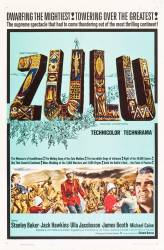Factual error: In the climactic charge scenes in which the three ranks of British soldiers deliver volley after volley into the Zulu masses, the soldiers closest to the camera are correctly equipped with lever action Martini-Henry rifles but those further back in the line can be seen pulling up and back on bolt action rifles, wrong for the era.
Factual error: A bit of dramatic license was taken by the scriptwriters. Though portrayed in the film as a skiving drunkard, in real life Private Hook was considered a model soldier who was a lifetime teetotaller. Hook was receiving good conduct pay at the time of the battle.
Factual error: The 24th is identified as the "South Wales Borderers." In 1879, the regiment was the 2nd Warwickshire. It did not become a Welsh regiment until 1881.
Factual error: Colour Sergeant Bourne was in fact rather a small man (which Nigel Green is not) and was actually, in his early 20s, the youngest colour sergeant in the British Army.
Factual error: Assistant Commissary Dalton, portrayed as a bit of an upper-class twit in the film, was in actuality a former infantry quartermaster sergeant and the most experienced soldier in the garrison. He helped to plan the defense.
Factual error: Lieutenants Chard and Bromhead were both rather elderly for their ranks (in their mid-30s) and Bromhead's career had begun to suffer due to a hearing problem. Like most members of the garrison, both had full beards.
Factual error: In history, the battle at Rourke's Drift was NOT ordered by Cetewayo. Cetewayo gave specific commands to his men not to attack any entrenched British positions; the Rourke's Drift assault was in fact spearheaded by one of his headstrong siblings eager to prove his warrior worth to his brother.
Factual error: In the actual battle the wagons were not tipped over, the space beneath was filled with mealie bags and ammunition boxes. This made the bayonet equipped rifles more effective against the much shorter assagais, since the assagai-armed Zulus could not engage without climbing onto the wagons.
Factual error: After the battle, the remaining Zulus left the field without making a sound, unlike the movie.
Factual error: Stanley Baker (in the scene where he reloads his revolver) is shown using a Webley Mark VI - not issued until 1915.
Suggested correction: The film company and production unit tried to find revolvers of the sort that would have been used by British army officers in the 1870s. They were unable to find hand held firearms of the appropriate date, and so had to issue Stanley Baker/Lieutenant Chard and Michael Caine/Lieutenant Bromhead with First World War era handguns as the best possible substitute. Everybody was aware that this was historically inaccurate, but this was the best they could do under the circumstances.
Explaining why or how a mistake occurred does not invalidate it. This correction isn't valid.
Factual error: The Swedish missionary Otto Witt is portrayed as a drunkard who encourages the soldiers to abandon their posts. In reality Otto Witt helped the defense by helping to build the barricades. He later volunteered to assist as a lookout on the nearby hill. He departed before the battle to join his wife and two daughters at a nearby farm.
Factual error: Conversely Corporal Allen, portrayed as the model soldier, was demoted from sergeant (his previous rank) for drunkenness before the battle.
Factual error: Henry Hook in fact retired from the Army as a Sergeant-Instructor, hardly the barrack-room lawyer as which he is portrayed.
Factual error: At the begining of the film, Chard and Bromhead do not know one another and during the preparations for the defence it is indicated that Chard and Commissary Dalton do not know each other. Chard had actually been stationed at Rorke's Drift for several days before the battle and knew both Bromhead and Dalton.
Factual error: Several of the Martini-Henrys shown in the movie are later models that could not possibly have been present at Rorke's Drift. These include the Mark III, Mark IV, and several variants of the Francotte Cadet and Boer ZAR Contract Westley-Richards (neither manufactured until 1895) along with Bromhead's hunting rifle. One of the Zulus is even carrying a Martini-Enfield .303 Carbine, not manufactured until 1899.
Suggested correction: When they were making Zulu they could only obtain a limited number of firearms that would have been available in 1877. They had to make do by supplying the actors with firearms from later dates.
Explaining why or how a mistake occurred does not invalidate it. This correction isn't valid.
Factual error: Dabulamanzi led the Zulus attacking Rorke's Drift. He was either a brother or half brother of Cetewayo, not one of his sons.
Factual error: When private Hitch is wounded, he is shot in the leg. He was actually shot in the shoulder. The bullet shattered his shoulder blade and he was invalided out of the Army as a result.
Factual error: Another commissary (senior to Dalton) and an army chaplain (who distinguished himself by handing out ammunition during the battle) were also present in the garrison.
Factual error: The webbing the British soldiers wear is incorrect. They are wearing Slade Wallace which is 1888 onwards. They should be wearing 71 Valise pattern.
Factual error: In the hospital, Corporal Friedrich Schiess tells William and Robert Jones that he's a member of the Natal Mounted Police. In actuality, Cpl. Schiess was a member of the Natal Native Contingent, a distinctly different branch of the colonial forces. The Natal Mounted Police did, however, have three men present at the Battle of Rorke's Drift: Troopers Lugg, Green, and Hunter, and Trooper Henry Lugg later published two detailed accounts of the battle.





